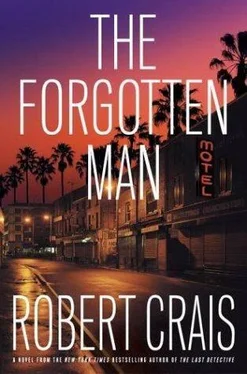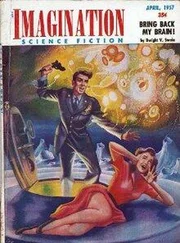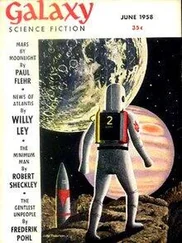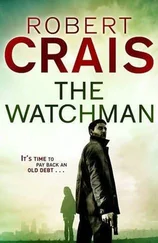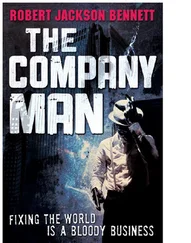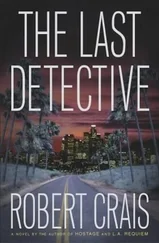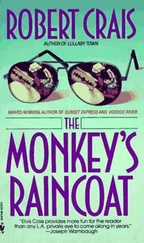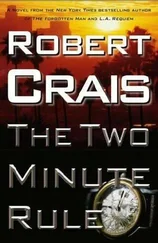"Okay, Pardy. I'll see you."
He leaned across the seat and held out his card.
"Take my cell. You might need to call me."
I watched Pardy drive away, then walked around the side of Diaz's apartment to a cracked cement courtyard overgrown with bougainvillea. A small balcony hung out from the second floor with wooden steps going up to a narrow door. A similar door was tucked beneath the balcony. It took eight minutes to pick the locks.
Diaz had a small place, with one bedroom and a bath sprouting off the kitchen and living room. The furniture was mismatched and spare, with the temporary quality of a resident hotel, as if Diaz was only passing through on the way to somewhere else.
The murder book was on her dining table. She hadn't hidden it, or even attempted to hide it. Like every other murder book, it was a dark three-ring binder. Her family name was written on the binder's spine. Diaz.
I walked through her apartment because you always have to walk through, looking for bodies or lurkers, then returned to the table. I sat with the murder book just as she must have sat. I opened it.
The pages felt thin, but weren't yellow or brittle. The first document was a standard form stating the facts of the crime. The lead detective was identified as Detective-Sergeant Max Alvarez., but the form was signed by Detective Korvin Tolbert. Leads often left the paperwork to their partners.
At 1915 hrs on 22 May 69, RO/s Padilla (#1344) and Bigelow (#6191) entered private residence at 625 Court Lane, Temecula, in response to summons by neighbors. Upon entering residence, RO/s observed three deceased (see below) and surviving minor child (see below). RO/s secured scene. Detectives M. Alvarez (#716) and K. Tolbert (#1952) arrived 2025 hrs. At that time, Coroner's Office pronounced victims dead of apparent homicide.
Photo ID (DL) found at scene and vis. ident. by neighbors (see below) provided prelim. identification of victims as Herman Eduardo Diaz, age 36; his wife, Maria Diaz, age 32; their son, Richard Raul Diaz, age 12. Confirmed ID pending Medical Examiner. Initial indications were the three suffered severe blunt-force trauma to the head. A 30-inch Louisville Slugger baseball bat was recovered at the scene, and has been submitted for tests. Bat evidenced blood, tissue, and hair. (See below.)
Neighbors identified unharmed female minor child as Kelly Louise Diaz, age 4, the daughter of Herman and Maria. No attempt was made to question child at scene. Child was taken into custody by Children's Services pending next of kin.
When I saw the little girl's full name, my breath hissed out in a soft low sigh. Kelly Diaz's family had been bludgeoned to death with a baseball bat twelve-point-two miles from the Reinnikes' house, nine days before the Reinnikes disappeared. Kenneth Dupris's dog had been stabbed to death two days earlier. David Reinnike had been accused of stabbing a collie, and had once attacked another child with a baseball bat. Thirty-five years later, LAPD Detective Kelly Diaz had been the only one present when David Reinnike's father, George, was murdered in an alley.
The first report was only three pages long. Tolbert had written it on the morning after the murder, so his initial facts were spare, but later that day he attached reports written by the responding officers, and statements from neighbors. The victims were discovered by a neighbor who had gone to ask if her children could stay with the Diaz family that night while she visited a hospitalized friend. She believed them to be home because their cars were in the drive. No one responded to her knocking, but the door was ajar, so she pushed it open and announced her presence. That's when she saw Maria Diaz lying on the blood-saturated carpet.
A sketch followed the initial statements, showing the location of the bodies and the baseball bat. Each body was a little stick figure with initials written beside it. Tolbert noted that the premises had not been vandalized, the vehicles had not been stolen, and nothing appeared to be missing. Robbery was not considered a motive, but would not be ruled out until further investigation.
The next pages contained photographs of the crime scene. The first showed Maria Diaz facedown behind a couch. Her head was a red mass of hair and tissue. She was wearing shorts and a black T-shirt emblazoned with MOTHERS OF INVENTION.
Herman Diaz was in the second picture. He was on his back, staring at a ceiling he could not see. The blood had pooled around his head, fanning from his face like red petals.
The third picture showed their twelve-year-old son, Richard. He was partially hidden under the kitchen table, but a thin smear of red trailed across the floor as if left by a mop. Her brother had been trying to escape.
I felt light-headed, and realized I had stopped breathing. I looked up and breathed deeply.
I flipped past pictures of splatter patterns and smudgy footprints. Sheriffs Department criminalists had isolated a partial thumbprint on the kitchen door and three print fragments on the baseball bat, but had been unable to establish an identity. They also found partial impressions on the kitchen floor consistent with a cleated, size-twelve work boot, suggesting an adult male assailant of average size and weight.
Most of the remaining reports, statements, and interviews were entered into the murder book during the three weeks following the crime. Tolbert entered the lab reports as they arrived, but their results-like the interviews and the rest of the investigation-offered nothing useful. No suspects had been identified, and after a time the investigation turned cold.
Tolbert's last report was dated sixteen weeks after the murders. Maria's sister, Teresa Evans, had gone through her sister's possessions, and reported that a heart-shaped necklace was missing. The necklace was described as a simple silver heart that had originally belonged to their grandmother. She told Tolbert that Maria wore it as her everyday necklace, but it was not among the items returned to the family by the coroner, and had not been found in the house. Teresa had sent Tolbert a picture of Maria Diaz wearing the necklace. Tolbert had entered the picture into the murder book. Maria Diaz was wearing a bright spring dress. Her shoulders were tanned and pretty, and she was standing on someone's patio at twilight. She could have been Kelly Diaz's sister. The necklace stood out plainly. Kelly Diaz had been wearing the necklace when I went to see her at Central Station, and on the morning I stood with her over George Reinnike's body.
I closed the murder book, then went to the kitchen. I turned on the tap, and cupped my hand under the cool stream to drink. When I finished, I wiped my hand on my pants, then returned to the dining room.
Alvarez and Tolbert hadn't tied the Reinnikes to the murders because their disappearance was never reported; they had simply paid their rent and vanished. Their landlord had no reason to suspect a crime, and was happy to be rid of them. Six years later when the police busted his then-current tenant for mail fraud, the murders were forgotten news. Nothing in the murder book identified the Reinnikes as suspects, but Kelly Diaz had ended up in an alley with George Reinnike. And clippings about me.
Diaz probably hadn't found Reinnike; George had probably found her. He paid them to pray. After a lifetime of guilt, George had probably sought out Diaz to beg her forgiveness, and brought her mother's necklace as proof that he was involved in the killings. Even his alias spoke to his guilt: Keller… Kelly. He had taken her name as he had desecrated his flesh-to suffer a daily reminder of his sin. Reinnike probably hadn't known of me, and had never heard of me; he had come to Los Angeles looking for Kelly Diaz.
The more I thought about it, the more convinced I became that Diaz planted the clippings about me. She planted the key card in the alley and more clippings in Reinnike's motel room to hook me into tracing Reinnike, and it had worked. Maybe Reinnike confessed everything to Diaz except for David's whereabouts, so she needed a way to find him that wouldn't put herself at the forefront of the search. Me. The World's Greatest Detective would find David, then she could kill him just as she had killed his father.
Читать дальше
